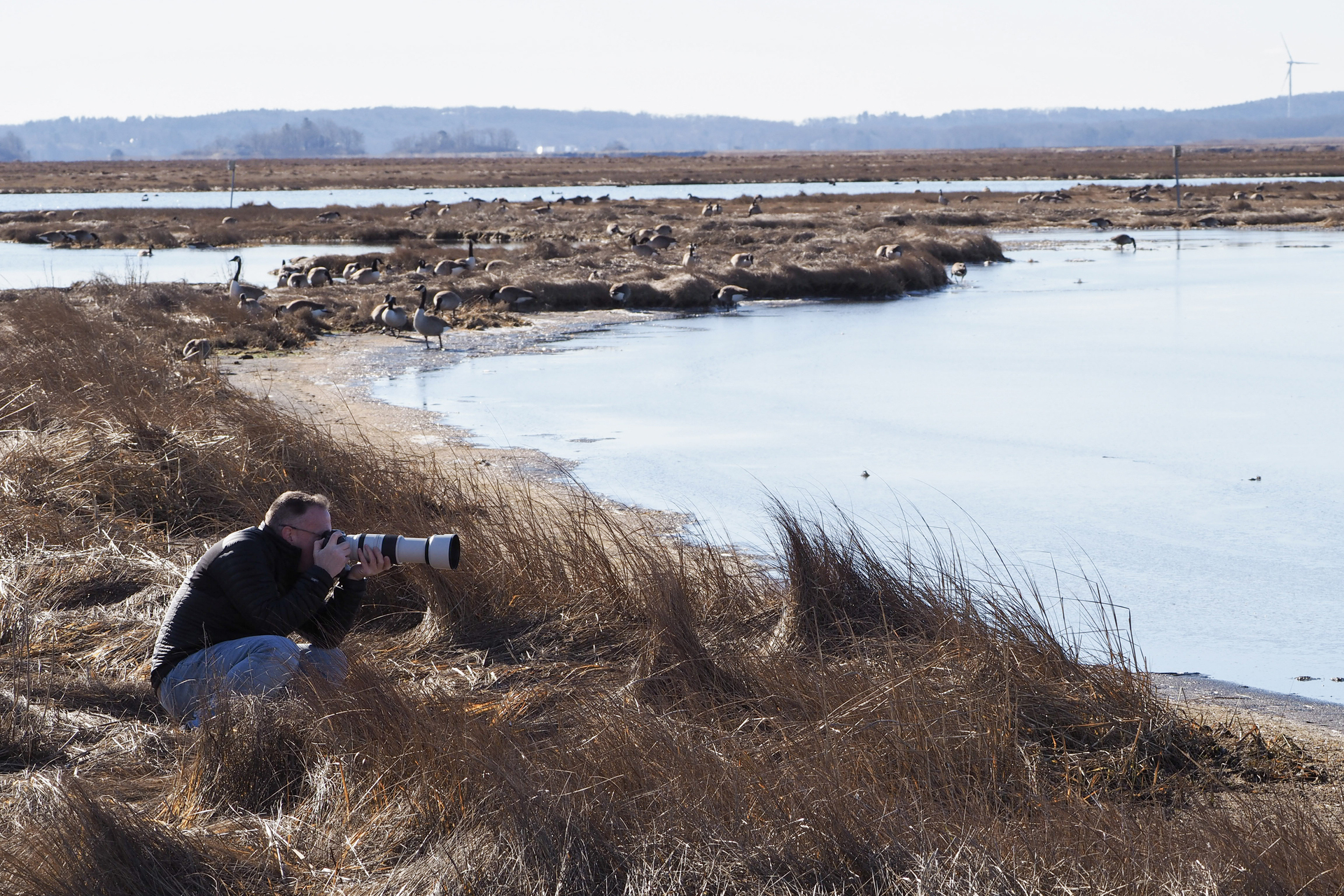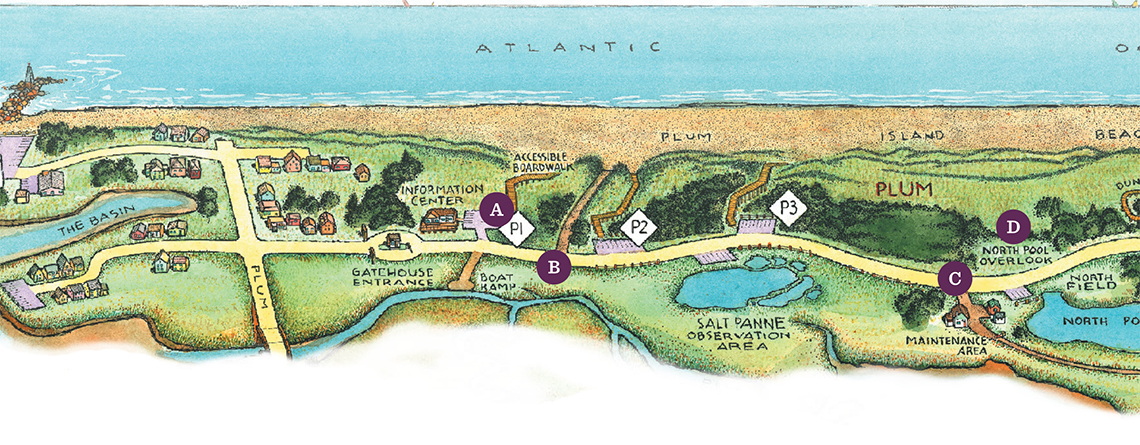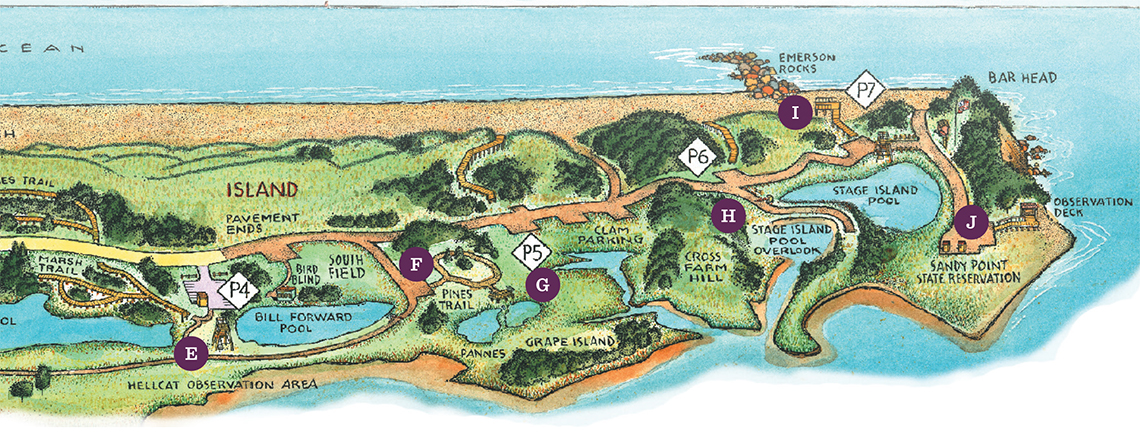The vast Parker River National Wildlife Refuge occupies all but the northern third of the island. Mass Audubon has a long history of partnership with the refuge on a variety of science and bird monitoring initiatives, including the operation of a bird-banding station at the refuge along with public birding programs.
Since the refuge itself contains so many distinct areas to bird, we've compiled this short site guide to help first-timers get the lay of the land. So, dress warm for the cold wind off the ocean, pack a spotting scope or a good pair of binoculars if you have them for scanning wide expanses of marsh and beach, and get ready to see some unique winter birds!
Where to Look for Birds
Before arriving at the refuge, stop at Mass Audubon's Joppa Flats Education Center. Go inside to ask staff about recent sightings and conditions and then scan the Merrimack River for river-loving ducks like Common Goldeneyes.
Proceeding to the refuge entrance gatehouse on Sunset Drive, where you'll pay $5 per car for admission, take your first left into Parking Lot 1 (A), the first of a series of numbered lots on the ocean side of the island. The end of the boardwalk here is a great place to look for sea ducks like scoters, eiders, and grebes, as well as more open-ocean birds like Razorbills and Black Guillemots. It's rare to see these birds close to shore, so binoculars or a spotting scope can help.
Just beyond Lot 1 (B), Snowy Owls are occasionally seen in the dunes to the left and marsh to the right. A large pullout to the right at the "Main Panne" is a great place to stop and scan for them, as well as a variety of freshwater ducks when the water is ice-free.
Continuing south through a series of bends in the road known as "The S-curves," you'll enter the first stretch of forest on the island. Look in treetops and outer branches for a stationary Northern Shrike or a small raptor like a Merlin. In some years, observers have seen Barred Owls perched lower to the ground.
The next two pullouts on the right—the first leading to a pair of maintenance sheds with a restroom (C), and the second marked as the North Pool Overlook (D)—offer occasional chances to see two lesser-known winter raptors: Rough-legged Hawks and Short-eared Owls, the latter rarely seen except at dawn and dusk. Check for raptors in distant conifers standing alone in the marsh. The North Pool Overlook offers another chance to see freshwater waterfowl.
Just before the paved road turns to gravel, a parking lot on the right leads to the Hellcat Wildlife Observation Area (E), where a new, wheelchair-accessible boardwalk meanders along the marsh dike and through the forest and dunes. While the woodland trails can hold interesting passerines (small perching birds) in spring and fall, they tend to be quiet in winter. Your best bet at this time of year is to walk along the dike, checking the salt marsh for raptors and ducks.
For a chance to see winter passerines—finches in particular—go farther down the road to the wheelchair-accessible Pines Trail (F). This quarter-mile trail passes through conifers that are visited in some years by flocks of crossbills and other uncommon, unpredictable finches. A spur off of the Pines Trail takes you to Lot 5 (G), which sometimes holds Common Redpolls or Pine Grosbeaks (but only in years when these nomadic birds are around).
Across from Lot 6 on your left, a trail on the right leads out to Stage Island (H), a small hill in the marsh that is a great place to scan for Short-eared Owls and Northern Harriers hunting rodents.
The platform overlooking Emerson Rocks at Lot 7 (not the observation tower) (I) is one of the best places on the island to find seabirds, especially at lower tides: Black, Surf, and White-winged scoters, grebes, loons, and Common Eiders often scour the rocky substrate for tasty invertebrates.
Finally, Sandy Point State Reservation (J) sits at the southernmost end of the island. The wide expanse of beach and dune grass here is an excellent spot to seek out small, tundra-breeding birds that like barren ground, such as Snow Buntings and Horned Larks. Occasionally, winter shorebirds like Dunlins and Sanderlings skitter across the surf line.
Bird RespectfullyPlum Island has become so popular with birders and photographers in recent years that certain sought-after species like Snowy Owls are suffering from a bit too much attention. These birds travel great distances to reach Plum Island and they need to conserve calories and rest when they aren’t hunting. You can help by giving these birds plenty of space, and moving on after a minute or two of quiet observation. Keeping your distance—at least 50 yards if you're standing on the road, or 200 yards elsewhere—will keep the birds safe and encourage them to continue returning to the refuge for more bird-lovers to enjoy! |
Join a Program
Guided bird outings are the best way to get a feel for birding Plum Island, led by an expert intimately familiar with the refuge. Joppa Flats Education Center staff host Wednesday Morning Birding—a weekly tradition for 25 years—and other wildlife sanctuaries like Ipswich River often run other bird- or nature-themed programs at the refuge. Visit massaudubon.org/programs to sign up for one.





